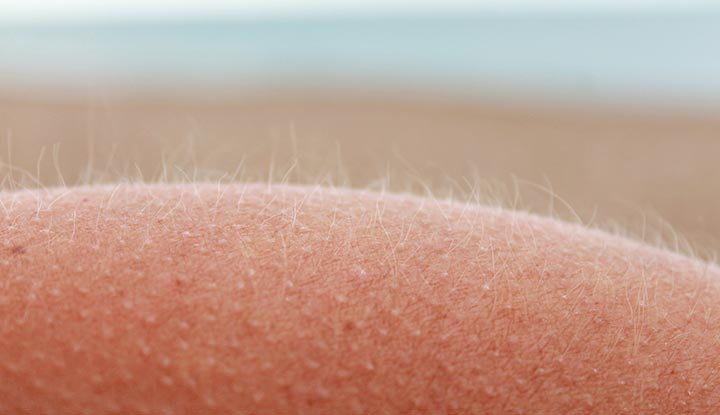Vellus hair (peach fuzz) is fine, short hair that grows all over your body, including your face, stomach, arms and legs. Vellus hair helps regulate your body temperature and protects your skin. Excess vellus hair growth can be a sign of some health conditions, such as Cushing syndrome. If you don’t like how vellus hair looks, you can remove it.
Advertisement
Cleveland Clinic is a non-profit academic medical center. Advertising on our site helps support our mission. We do not endorse non-Cleveland Clinic products or services. Policy

Vellus hair is thin, fine hair that grows on most of your body. You might know it as “peach fuzz.” It’s different from the thicker, longer hair you have on your scalp, which healthcare providers call terminal hair. Vellus hair is usually lighter and shorter than terminal hair. The length, thickness and color of vellus hair vary from person to person.
Advertisement
Cleveland Clinic is a non-profit academic medical center. Advertising on our site helps support our mission. We do not endorse non-Cleveland Clinic products or services. Policy
Vellus hair protects your skin and helps your body cool down or stay warm. You’ll find these tiny hairs on your face, neck, arms, legs and trunk. Vellus hair doesn’t grow on the soles of your feet, the palms of your hands or your lips and eyelids.
Abnormal vellus hair growth can be a sign of some health conditions.
If you don’t like the appearance of vellus hair, you can remove it. Some techniques can remove vellus hair permanently.
These thin, little hairs help regulate your body temperature. They keep your skin warm by providing insulation. They also help your body wick away sweat, which cools you off and helps you avoid heat illness.
Vellus hairs also protect your skin and help you sense the world around you. The tiny hairs help you feel light objects against your skin. When you get goosebumps, your vellus hair allows you to feel them.
The hair on your scalp is terminal hair. It’s thicker and coarser than vellus hair. It grows longer and is usually darker than vellus hair on your body. Terminal hair tends to grow on your:
It usually appears on your:
Advertisement
For most people, vellus hair is thin, fine and wispy. It’s usually shorter and lighter in color than terminal hair. It ranges in color from light blonde to dark brown.
The appearance of vellus hair and the amount you have depends on your genetics, age and hormone levels. Vellus hairs usually shorten or fall out as you age. Children and young adults have more vellus hair than older adults.
During adolescent development (puberty), hormone levels rise. Your body’s endocrine system produces more of a type of hormone called androgens. This increase causes vellus hair on some parts of the body to change to terminal hair.
Vellus hair changes to terminal hair in the pubic area and armpits during puberty. It becomes darker and coarser. When males (and some females) go through puberty, vellus hair on their upper lip and beard area darkens and gets thicker. It also grows longer on the upper back, chest, knuckles, arms and legs.
Some medications, including chemotherapy drugs for cancer, cause terminal hair to fall out. These medications can also cause terminal hair to change to vellus hair. It may be possible for vellus hair to change back into terminal hair when you stop taking the medication.
In some cases, the amount and appearance of vellus hair can be a sign of a health condition or disorder. Conditions associated with abnormal vellus hair growth include:
People with eating disorders (anorexia nervosa and bulimia nervosa) may grow a type of hair called lanugo on skin all over the body. This results from lack of nutrition. Lanugo is slightly thicker (and more fur-like) than vellus hair. It grows on babies in the uterus as part of fetal development and falls out shortly after birth.
Advertisement
Although there isn’t a medical reason to remove normal vellus hair, you can get rid of peach fuzz if you don’t like the way it looks. Several methods are effective at removing vellus hair. Talk to your healthcare provider about the best option for you. They include:
Never try to bleach vellus hair. Bleaching can damage your skin and cause permanent changes in skin tone.
Peach fuzz doesn’t grow back thicker after you remove it. New vellus hairs may seem to be coming in thicker than they were before, but they’re not. It just seems like the hairs are thicker after shaving or removing them because the top part of the new hair has to push through your skin’s surface as they grow back. They’ll feel softer as they grow.
Advertisement
Vellus hair, or peach fuzz, protects your skin and helps your body regulate its temperature. These fine, thin hairs do important work all over your body. If you’re not happy with how vellus hair looks, there are ways to remove it. Talk to your healthcare provider about the right option for you and whether you want to remove peach fuzz temporarily or permanently. If you notice an increase in vellus hair, see your healthcare provider. Excessive vellus hair growth can be a sign of a medical condition.
Advertisement
Cleveland Clinic’s primary care providers offer lifelong medical care. From sinus infections and high blood pressure to preventive screening, we’re here for you.

Last reviewed on 05/24/2022.
Learn more about the Health Library and our editorial process.